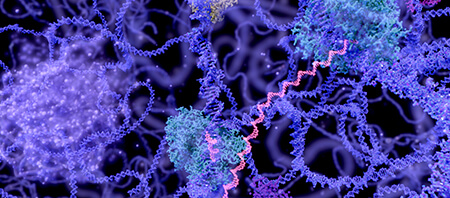<< Back to MOTIFvations Blog Home Page
Multiplex Single-Molecule Resolution Epigenetic Analysis with ChIA-Drop & More Epigenetics News

March 1, 2019
The epigenetics field is moving quickly, hundreds of new papers are published every month, making it hard to keep up with the newest findings. We’re trying to make it a little easier for you to stay up-to-date in this exciting area by scouring the literature and bringing you short and easily digestible summaries of the most interesting and most impactful discoveries in epigenetics research each month.
This month we cover ChIA-Drop, a new method for investigating chromatin interactions with single-molecule precision, a role for DNA methylation in coronary artery disease, and an epigenomic study that identified DNA sequence motifs associated with histone modifications in both human and mouse cells.
New ChIA-Drop Method Measures Multiplex Chromatin Interactions with Single-Molecule Precision

While we often think of double helix structure of DNA, the real three-dimensional structure of DNA in the context of chromatin is much more complex. DNA is tightly associated with histones and other proteins and its three-dimensional structure plays an important role in many areas of molecular and cellular biology.
A new study recently published in the journal Nature describes the development of a new assay to investigate chromatin interactions with single-molecule precision. The scientists named their experimental approach ChIA-Drop, which stands for chromatin interaction analysis via droplet-based microfluidics. Their method separates the chromatin sample being investigated into single-molecule droplets using the Chromium microfluidics system from 10X Genomics. They also developed an accompanying bioinformatics and analysis pipeline that they called ChIA-DropBox
The researchers validated the performance of their new method by analyzing the chromatin interactions in Drosophila cells. They found that the chromatin structural features mainly contain multiplex chromatin interactions with high amounts of heterogeneity. ChIA-Drop also generate new data on the associations of promoter sequences with other genomic regions in the nucleus, which is an aspect of transcription historically underappreciated due to previously technical limitations.
Reference: Zheng, M. et al. Multiplex chromatin interactions with single-molecule precision. Nature 566: 558-562. (2019)
Link
Role for DNA Methylation in Coronary Artery Disease

It is generally understood that the differentiation and development of blood cells, such as macrophages, is regulated by DNA methylation. However, the details regarding which genes are specifically regulated by this epigenetic modification remain largely unknown.
A recent paper published in the journal Scientific Reports by a team of researchers in India reports on the investigation of the epigenetic profile of M1 macrophages and their effect in atherosclerosis. A case-control study was performed with 25 coronary artery disease (CAD) patients and 25 controls to study the promoter DNA methylation status of STAT1, STAT6, MHC2, IL12b, iNOS, JAK1, JAK2, and SOCS5 using methylation sensitive high resolution melting (MS-HRM) analyses.
Their data indicates that there was a clear-cut difference in the pattern of gene-specific promoter DNA methylation of CAD patients in comparison to controls. These findings highlight potential DNA methylation biomarkers as well as indicate that epigenetic inhibitors might be effective in treating cardiovascular disorders such as coronary artery disease.
Reference: Bakshi, C. et al. Aberrant DNA methylation of M1-macrophage genes in coronary artery disease. Sci. Rep. 9: 14292. (2019)
Link
Of Mice & Men: New Epigenomic Analysis Identifies DNA Motifs Responsible for Regulating Histone Modifications in Human and Mouse

Although many of the enzymes that add and remove histone epigenetic modifications have been discovered, the exact mechanisms by which these epigenetic modifications are regulated are generally not very well understood.
In their recent work published in the journal PNAS, Vu Ngo and collaborators at the University of California at San Diego have analyzed 6 histone marks (H3K4me1, H3K4me3, H3K27ac, H3K27me3, K3H9me3, H3K36me3) in greater than 100 different human cell types and tissues from the NIH Roadmap Epigenomics Project as well as 8 histone marks (the previous 6 plus H3K4me2 and H3K9ac) from the mouse ENCODE Consortium.
They have identified 361 DNA motifs in the human samples and 369 DNA motifs in the mouse cells that appear to be involved in the regulation of each histone mark. These DNA elements tend to preferentially appear in regulatory regions such as promoters and enhancers, consistent with the role of epigenetic modification of histones in the regulation of gene expression.
Reference: Ngo, V. et al. Epigenomic analysis reveals DNA motifs regulating histone modifications in human and mouse. Proc Natl Acad Sci U S A. 116: 3668-3677 (2019)
Link
<< Back to MOTIFvations Blog Home Page





